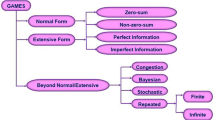Abstract
Game theory is a popular tool for designing interaction protocols for agent systems. It is currently not clear how to extend this to open agent systems. By “open” we mean that foreign agents will be free to enter and leave different systems at will. This means that agents will need to be able to work with previously unseen protocols. There does not yet exist any agreement on a standard way in which such protocols can be specified and published. Furthermore, it is not clear how an agent could be given the ability to use an arbitrary published protocol; the agent would need to be able to work out a strategy for participation. To address this we propose a machine readable language in which a game theory mechanism can be written in the form of an agent interaction protocol. This language allows the workings of the protocol to be made public so that agents can inspect it to determine its properties and hence their best strategy. Enabling agents to automatically determine the game theoretic properties of an arbitrary interaction protocol is difficult. Rather than requiring agents to find the equilibrium of a game, we propose that a recommended equilibrium will be published along with the protocol; agents can then check the recommendation to decide if it is indeed an equilibrium. We present an algorithm for this decision problem. We also develop an equilibrium which simplifies the complexity of the checking problem, while still being robust to unilateral deviations.
Similar content being viewed by others
References
Bernheim D., Peleg B., Whinston M.(1987). Coalition-proof Nash equilibria I: Concepts. Journal of Economic Theory 42(1):1–12
Binmore K.(1992). Fun and games: A text on game theory. D.C. Heath and Company, Lexington, Massachusetts
Conitzer, V., Sandholm, T.(2004). Self-interested automated mechanism design and implications for optimal combinatorial auctions. In: Proceedings of the ACM Conference on Electronic Commerce (ACM-EC) (pp. 132–141). ACM Press.
Dash, R.K., Jennings, N.R.,& Parkes, D.C.(2003). Computational-mechanism design: A call to arms. IEEE Intelligent Systems, (pp. 40–47). November 2003. Special Issue on Agents and Markets.
Daskalakis, C., Goldberg, P.W., & Papadimitriou, C.H.(2006). The complexity of computing a nash equilibrium. In STOC ’06: Proceedings of the thirty-eighth annual ACM symposium on Theory of computing (pp. 71–78) New York, NY, USA: ACM Press.
Esteva, M., Rodriguez, J., Sierra, C., & Garcia, P.(2001). On the formal specification of electronic institutions. In: LNAI 1991, (pp. 126–147). Springer.
Fudenberg, D., & Tirole, J.(1991). Game theory. MIT Press.
Garcia-Camino, A., Rodriguez-Aguilar, J., Sierra, C., & Vasconcelos, W.(2006). A rule-based approach to norm-oriented programming of electronic institutions. SIGecomm Exchanges (Newsletter of the ACM Special Interest Group on E-Commerce), 5.5.
Genesereth, M., & Love, N.(2005). General game playing: Game description language specification, 2005. URL http://games.stanford.edu/ gdl_spec.pdf.
Gibbons, R.(1992). A Primer in game theory. Prentice Hall.
Giordano, L., Martelli, A., & Schwind, C.(2003). Specifying and verifying systems of communicating agents in a temporal action logic. In AI*IA 2003: Advances in Artificial Intelligence; LNCS (vol. 2829, pp. 262–274). Springer-Verlag.
Gottlob G., Greco G., Scarcello F.(2005). Pure nash equilibria: Hard and easy games. Journal of Artificial Intelligence Research 24:357–406
Guerin, F., & Pitt, J.V.(2003). Guaranteeing properties for e-commerce systems. In J. Padget, D. Parkes, O. Shehory, N. Sadeh, (Eds), LNAI volume 2531: Agent-Mediated Electronic Commerce IV. Designing Mechanisms and Systems (pp. 253–272). Heidelberg: Springer-Verlag.
Guerin, F., & Pitt, J.V.(2003). Verification and compliance testing. In M.-P. Huget (Ed), LNAI volume 2650: Communication in Multiagent Systems: Agent Communication Languages and Conversation Policies (pp. 253–272.) Springer-Verlag.
Harrenstein, P., Meyer, J.-J., van der Hoek, W., & Witteveen, C.(2000). A modal interpretation of Nash-equilibria and some related concepts. In B. Giacomo, E. Colombatto, W. van der Hoek, (Eds). Proceedings of the fourth conference on logic and the foundations of game and decision theory (LOFT4), June 30 – July 2 (pp. 1–21).
Koller D., Pfeffer A.(1997). Representations and solutions for game-theoretic problems. Artificial Intelligence 94(1):167–215
Manna Z., Pnueli A.(1992). The temporal logic of reactive and concurrent systems: Specification. Springer-Verlag, New York
Manna Z., Pnueli A.(1995). Temporal verification of reactive systems (Safety) (vol. 2). Springer-Verlag, New York
McKelvey, R.D., McLennan, A.M., & Turocy, T.L.(2006). Gambit: Software tools for game theory (version 0.2006.01.20, 2006) URL http://econweb.tamu.edu/gambit.
Nudelman, E., Wortman, J., Shoham, Y., & Leyton-Brown, K.(2004). Run the gamut: A comprehensive approach to evaluating game-theoretic algorithms. In Proceedings of the third international conference on autonomous agents and multi-agent systems (AAMAS-04). New York, NY (pp. 880–887).
Papadimitriou, C.(2001). Algorithms, games and the internet. In Proceedings of the annual symposium on theory of computing (STOC) (pp. 749–753).
Pauly M.(2005). Programming and verifying subgame perfect mechanisms. Journal of Logic and Computation 15(3):295–316
Pauly, M., & Wooldridge, M.(2003). Logic for mechanism design - a manifesto. InProceedings of the 2003 workshop on game theory and decision theory in agent-based systems (GTDT-2003). Melbourne, Australia.
van Eijk, R.M., de Boer, F.S., vand er Hoek, W. & Meyer, J.-J.: A verification framework for agent communication. Journal of Autonomous Agents and Multi-Agent Systems, 6(2), 185–219
Venkatraman M., Singh M.P.(1999). Verifying compliance with commitment protocols: Enabling open web-based multiagent systems. Autonomous Agents and Multi-Agent Systems 2(3):217–236
Wikipedia. Strategy (game theory), 2006.
Yolum P., Singh M.(2004). Reasoning about commitments in the event calculus: An approach for specifying and executing protocols. Annals of Mathematics and AI 42(1-3):227–253
Author information
Authors and Affiliations
Corresponding author
Rights and permissions
About this article
Cite this article
Guerin, F. Applying game theory mechanisms in open agent systems with complete information. Auton Agent Multi-Agent Syst 15, 109–146 (2007). https://doi.org/10.1007/s10458-006-9005-2
Published:
Issue Date:
DOI: https://doi.org/10.1007/s10458-006-9005-2




